On View
‘My Whole Life Has Been Following This Single Material’: How Liza Lou’s Obsession With Beads Transformed a Village in South Africa
The artist's show of glass-beaded works inaugurates Lehmann Maupin's new Chelsea gallery.
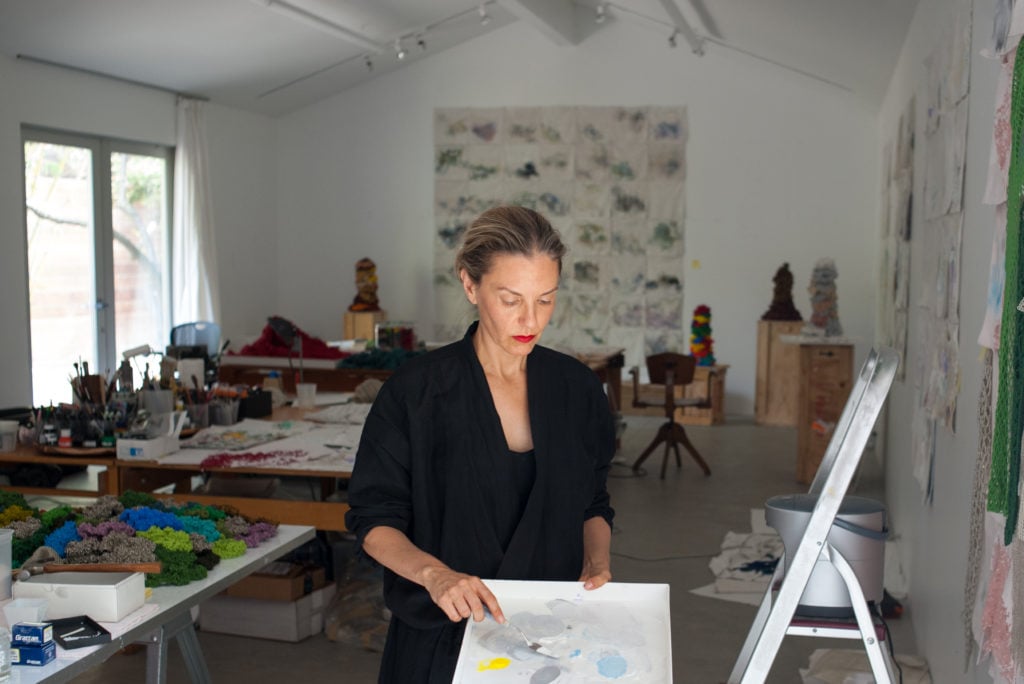
The artist's show of glass-beaded works inaugurates Lehmann Maupin's new Chelsea gallery.

Sarah Cascone

For three years, artisans in Durban, South Africa, have been stitching together the 600 beaded-cloth layers that make up the centerpiece of Liza Lou’s new exhibition in New York, the 100-foot-long canvas work The Clouds.
The piece, which debuted at the 21st Biennale of Sydney, is on view at Lehmann Maupin gallery’s new Chelsea flagship on West 24th Street. But it’s only part of the new show, “Liza Lou: Classification and Nomenclature of Clouds,” which is the artist’s first solo exhibition in New York in 10 years and stretches into the gallery’s West 22nd Street location as well.
Other works on view include Lou’s free-form beaded sculptures, smaller woven glass bead paintings, new large-scale drawings, and a multi-channel video. These bodies of work mark an evolution for the artist, who exploded onto the scene in 1996, when the New Museum’s then director Marcia Tucker exhibited Lou’s life-size installation Kitchen, a suburban kitchen where every surface was covered with glittering beads, elevating a traditionally decorative craft material to the realm of fine art.
To create her intricately beaded pieces, Lou has an army at her back. Back in 2004, she set out to complete a new project in Durban, enlisting a community of local women known for their expertise in beadwork. “It started with a new creative question,” Lou told artnet News. “In the same way that I think about what I’m going to make, I began to think about how I make what I make.”
She began thinking about who already had “a relationship with this material, and where the work could really make a difference in their lives,” she said. “In South Africa, there’s an enormous talent pool around beads that goes back generations, and there’s an enormous practical need for work. There was 70 percent unemployment in the townships. It was this marriage of two incredible opposing situations.”
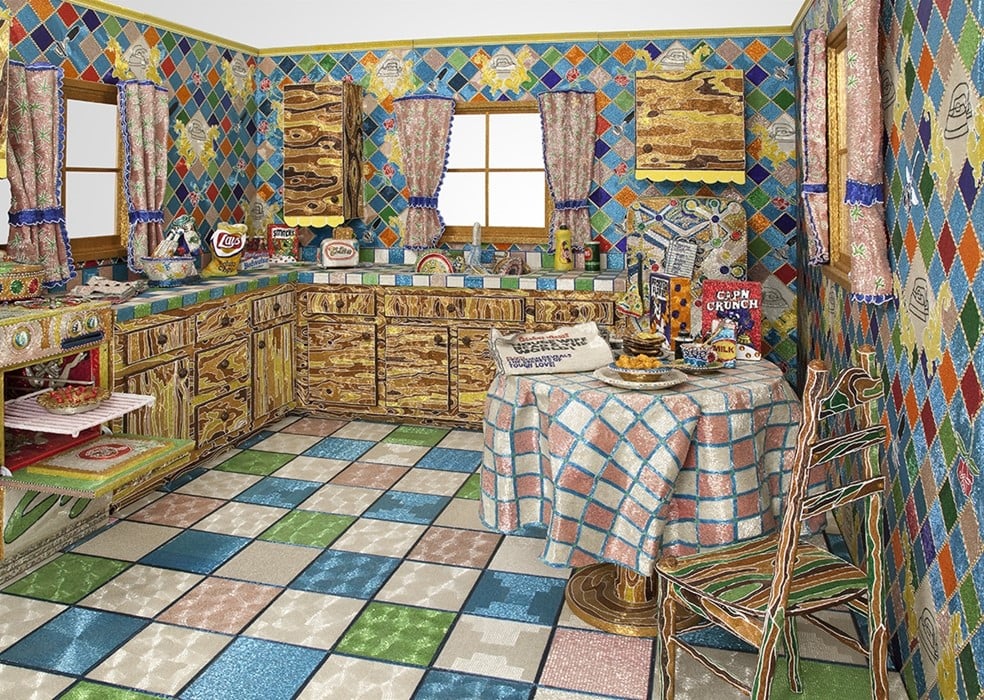
Liza Lou, Kitchen (1991–96). Photo by Tom Powell, ©Liza Lou, courtesy of the Whitney Museum of American Art, New York.
Lou ended up staying in Durban for ten years, working alongside local Zulu women. The studio has also grown to provide workers with scholarships, HIV testing, and other services. Some of the women that Lou first began employing have even gone on to hire assistants of their own.
“Sometimes it can get misinterpreted as, ‘Oh and then she provides for the poor Africans’—I hate that shit,” Lou said. “I hate seeing people with tremendous dignity, leaders in their community, treated as though they’re somehow needy or less-than. I find that to be super racist and insulting.”
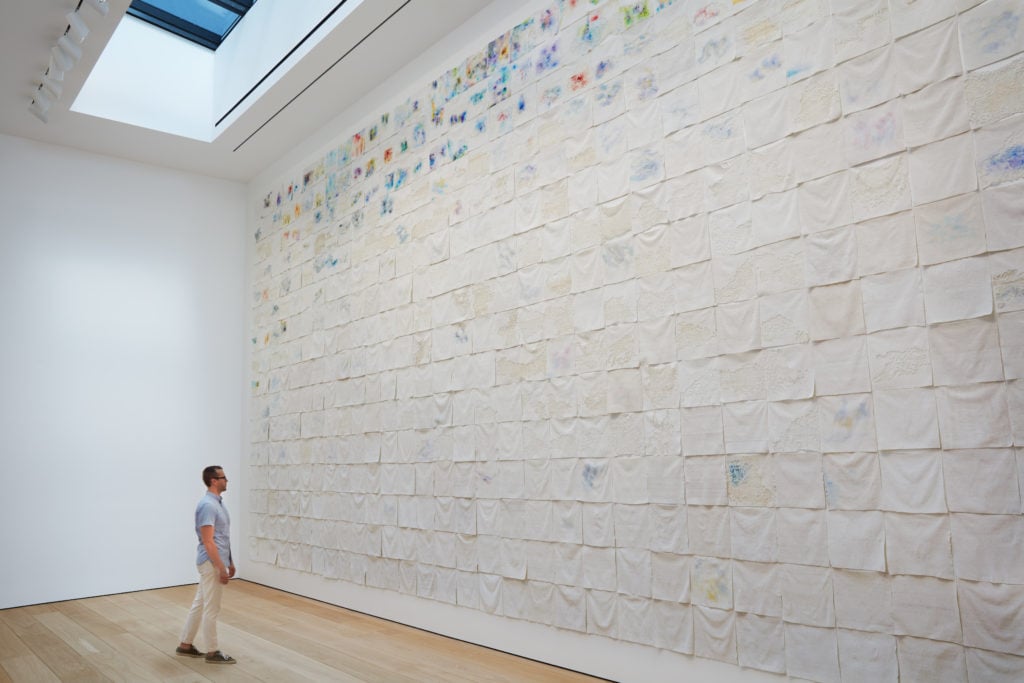
Liza Lou, The Clouds (2015–18), installation view of “Liza Lou: Classification and Nomenclature of Clouds” at Lehmann Maupin. Photo by Matthew Herrmann, courtesy of the artist and Lehmann Maupin, New York, Hong Kong, and Seoul.
The new show features what may be Lou’s most abstract works to date. Her boldly colored sculptures suggest coral reefs or mossy growths, the drawings perhaps topographic maps, while the shimmering beads and oil paint—a new addition to her beaded works—give the impression of evanescent clouds floating through the sky. In some cases, Lou took a hammer to the beaded cloths, breaking the glass beads and revealing the underlying networks of thread. In addition to adding a delicate, lacy quality to the works, this destructive action accentuates the hours of labor required to create each handmade cloth.
Lou is now back living in Los Angeles, but the workshop she built in South Africa continues to thrive. We spoke with Lou in New York about how her practice has changed since returning to the US, about what exactly it is about beads that captures her imagination, and how she finds new ways to work with a familiar material, even after decades.
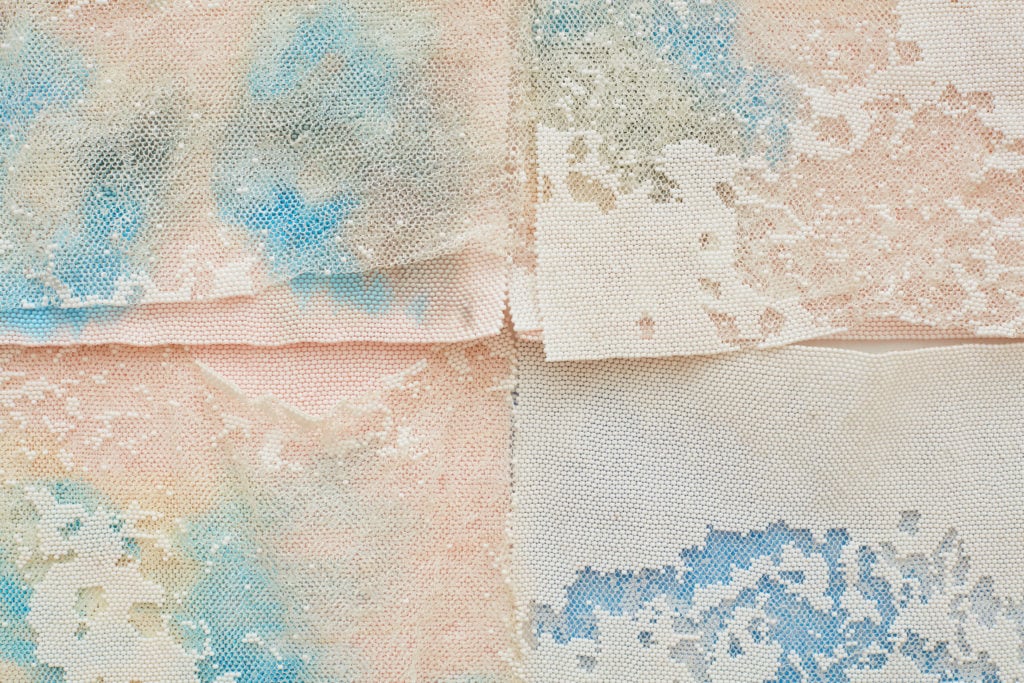
Liza Lou, Nacreous (2018), detail. Photo by Matthew Hermann, courtesy the artist and Lehmann Maupin, New York, Hong Kong, and Seoul.
At this point in your career, when you’ve worked for so long with this one unusual medium, how do you continue to find new directions in which to take your work?
To be tethered to a material is a burden, but it’s also an incredible opportunity. I don’t really choose to use beads. Every time I start a project, I start with an empty studio. Somehow or other, over the past 20 years, beads just seem to creep back in and become central to whatever I’m making. I’m always trying to disobey the material and what it naturally wants to do, but also to listen to it. I don’t set out to change bodies of work every time; I just get curious about something.
What were you curious about while working toward this exhibition?
The work evolved in an organic way. I found myself looking at clouds and photographing them. I’m not literally saying here’s a cumulus cloud, here’s a stratocumulus. I was thinking about clouds as a kind of poetic opening into thinking about abstraction, thinking about what’s ephemeral or fleeting, and putting that on top of a material and practice that I’ve had for many years that is rooted in craft, women’s work, labor, and working in community.
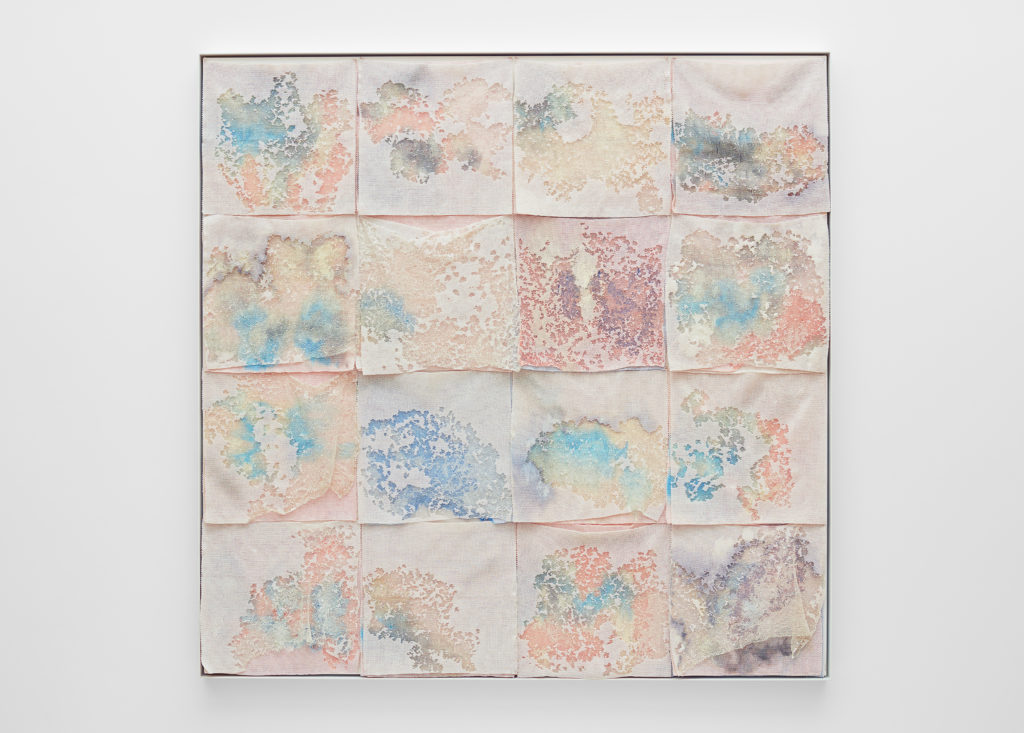
Liza Lou, Nacreous (2018). Photo by Matthew Hermann, courtesy the artist and Lehmann Maupin, New York, Hong Kong, and Seoul.
The show also includes some very intricate drawings and a video of you making them. How does this work fit in with the rest of your practice?
All three bodies of work were made simultaneously, over the past three years. I’ve had a drawing practice for many years. I noticed that when I draw, I intone sounds. When things are really quiet, you notice how much you sigh. You notice the grunts. I started to think, what does this practice sound like? What would happen if I recorded all that, and layered these sounds? Maybe I should share this.
[In the Durban studio] we were elbow-to-elbow. Being back in LA affords me the opportunity to work in solitude, which has led to painting and the drawing and the singing and the video. It has given me the opportunity to explore my own gesture in ways that I haven’t done in many many years.
At first, I was really missing the joy and the community aspect of how we worked [in Durban]. But what I found was that it’s possible to find great meaning if you stay grounded in your practice and get very quiet—that can bring about another kind of apotheosis. And for me it really did happen with the drawing practice and intoning these sounds as I was drawing.
It was a way of marking the time and being present every mark, every gesture I was making. We tend to valorize a certain type of gesture in our culture, but if we do something very simple and we do it well, there can be great meaning in that. That’s kind of how this work evolved.
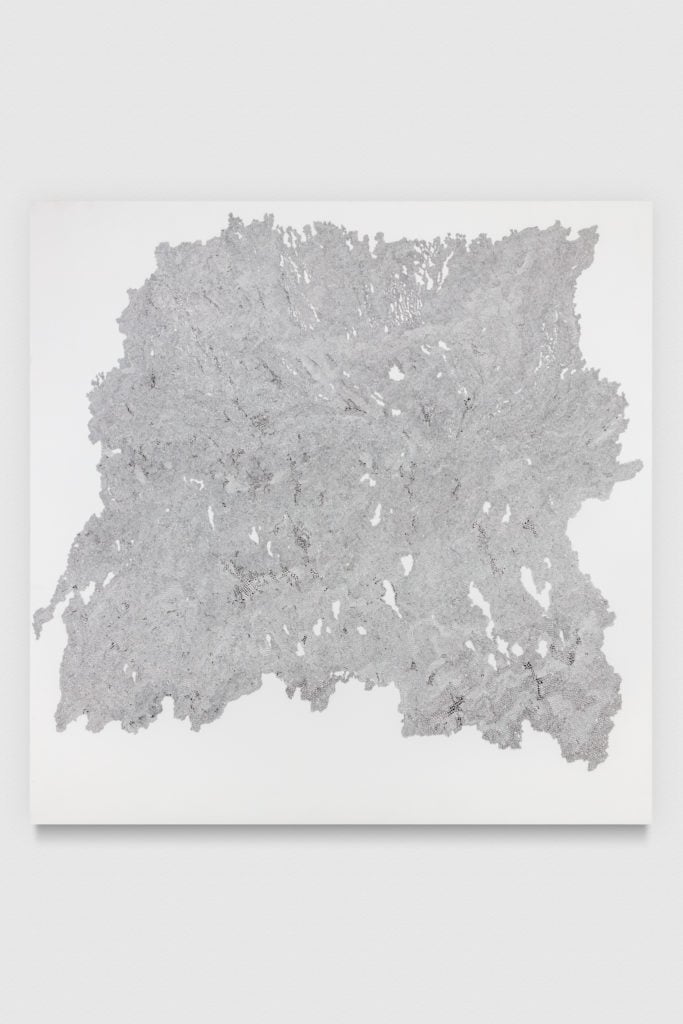
Liza Lou, Drawing Instrument II (2018). Photo by Joshua White, courtesy of the artist and Lehmann Maupin, New York, Hong Kong, and Seoul.
How did you put the video together? The sound in it is beautiful.
These are my “Drawing Instruments,” which are specifically made to intone onto. I think about them like a guitar. It’s a three-dimensional surface that I play. If I’m not making a sound, then there’s no drawing happening. I became very curious about what happens when you harmonize with yourself. What would happen if on Monday when I’m drawing, I intone in the key of C, and then on Tuesday I intone in the key of E so that later when I play the recordings together, it harmonizes? It’s the harmonizing of a practice.
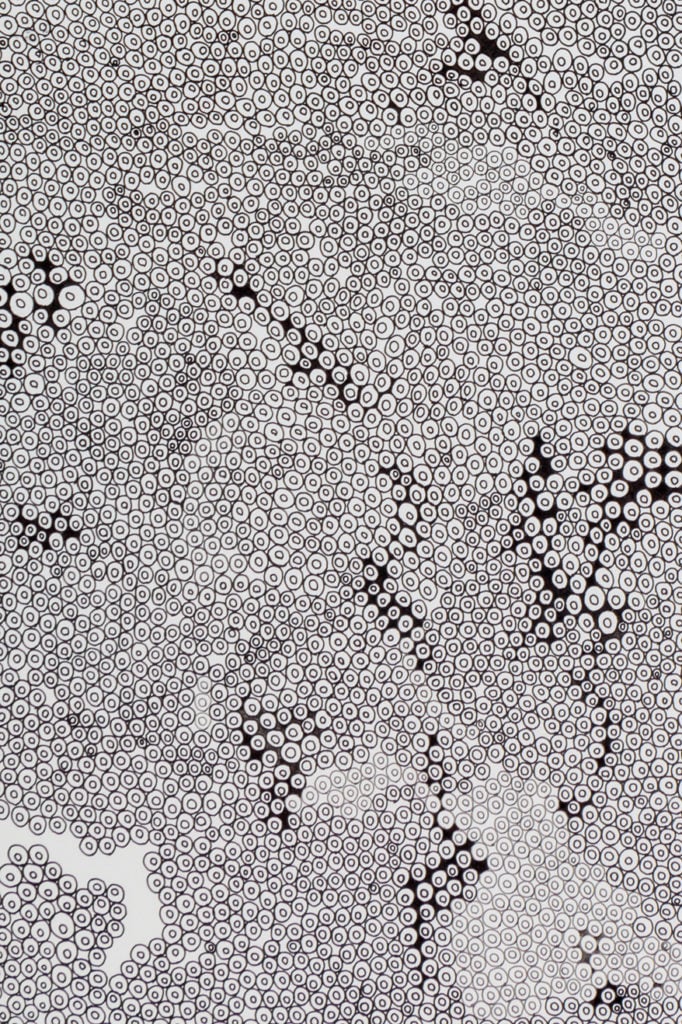
Liza Lou, Drawing Instrument II (2018), detail. Photo by Joshua White, courtesy of the artist and Lehmann Maupin, New York, Hong Kong, and Seoul.
The drawings also led to a new series of works with beads. Can you tell us about that?
I became curious about making organic clusters that might look like my drawings, which are these natural accretions. Beads tend to want to be on a grid pattern. That’s why you weave them, that’s why you seem them in clothing and on traditional Native American and African pieces. It’s super mathematical, actually.
I wanted to go off the grid. I worked with a factory in Japan to make the colors, shapes, and sizes of the beads and my thought was, is it possible to make a paint splat using glass beads? Is it possible to make something that looks gestural and quick and textural in the way of impasto paintings, where you see that kind of beautiful, thick, juicy paint?
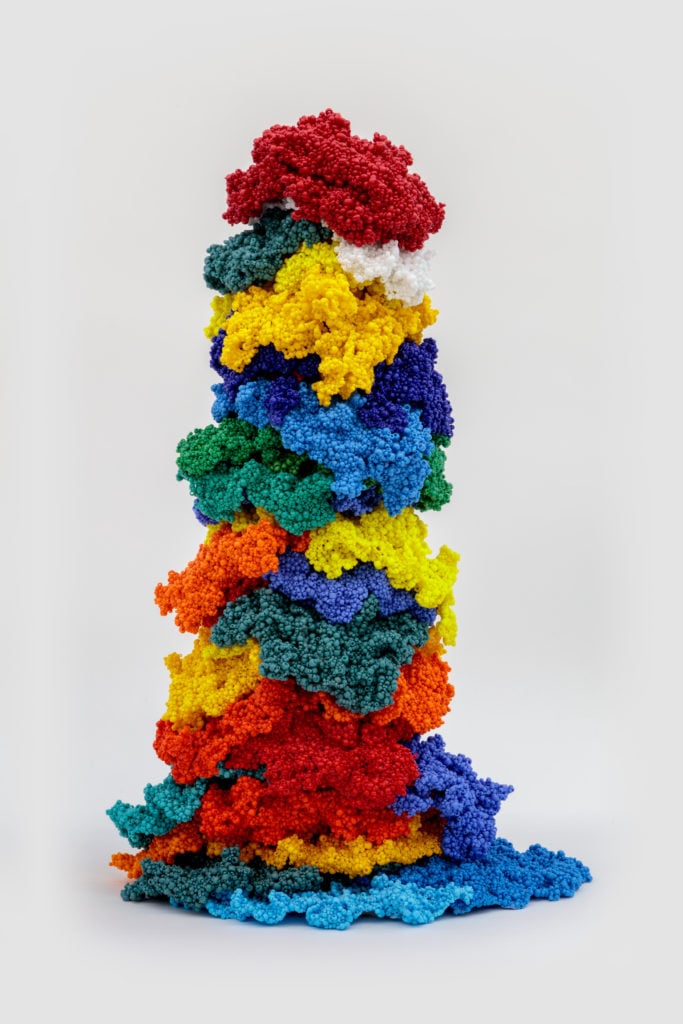
Liza Lou, Aggregate: Primary (2018). Photo by Joshua White, courtesy of the artist and Lehmann Maupin, New York, Hong Kong, and Seoul.
Was using the hammer a chance for you to take out some aggression after having to be so dainty and delicate with beads all these years?
What was super exciting for me about this body of work was getting out the hammer and smashing the materials straight up.
The thing about the material is that there’s a preciousness to it. Beads have a lot of connotations before you even make anything with them—around beauty, preciousness, and even labor. They’re made with a lot of care; they have their own value. It’s very, very laden. If I drop beads on the floor, I scrounge around and pick them up. I don’t just sweep them into the rubbish.
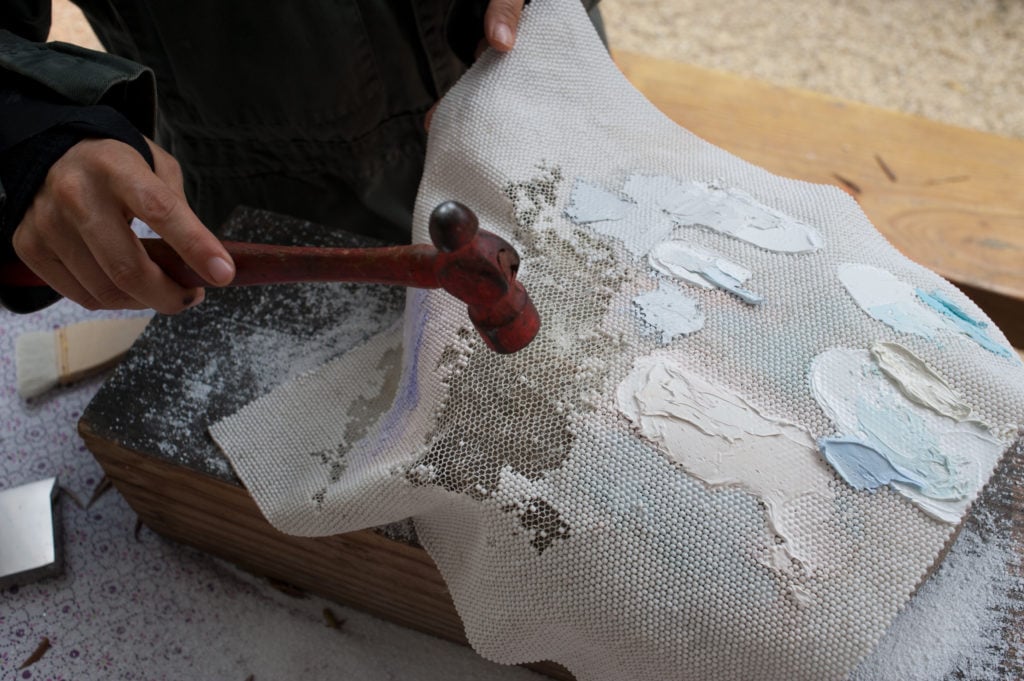
Liza Lou using a hammer to break some of her glass beaded “canvases.” Photo by Mick Haggerty, courtesy the artist and Lehmann Maupin, New York, Hong Kong, and Seoul.
To smash them is in a way destructive, but there’s also an element of making a mark. And it’s a way of revealing the work that goes into weaving. You can see how the piece was made. These cloths aren’t something you can go and buy. There’s not a shop. It’s a special thing that we make in my studio in Durban. They are sewn one at a time with needle and thread. You certainly can’t make one in a day. Each one is a few days of careful tending to minutia.

Liza Lou, Pyrocumulus (2018), detail. Photo by Joshua White, courtesy of the artist and Lehmann Maupin, New York, Hong Kong, and Seoul.
What is it like working at your studio in Durban?
I became very interested in the idea of a collective labor, of solidarity with women and solidarity in every stitch. The idea that the gesture, the paint that we were leaving behind, was the oils of our hands that were impregnating every cloth—to me that was a very beautiful, poetic way of thinking about painting. It was the bodily fluid being the gesture that we leave behind.
When I first got there, my idea and ethos for working there was that I wanted to work with women for whom this was really going to make a difference. None of the women who I worked with had ever had formal jobs.
In the early days of the studio, we did a lot of work around habilitating women out of poverty, running workshops with Zulu-speaking educators around issues such as having your own bank account, how to calculate interest—often times poverty works in a cycle. There are these scams that people fall into around interest and around purchasing things. We saw a lot of that happening with people who had never had money before.

Liza Lou and her team of Zulu artisans from her studio in Durban, South Africa, with The Waves at Galerie Thaddaeus Ropac in Salzburg in 2016. Photo by Byron Du Bois, ©Liza Lou.
[These initiatives weren’t] about trying to polish my halo or be a do-gooder. It was just about being responsible and ethical. How the work was made was as important as what was being made. It wasn’t about doing things faster or more cheaply. It was about doing things more beautifully, more carefully, and with real concern and care about the whole person who was working with me.
It’s about making a sane working environment where people can take care of themselves. I work with extraordinary women who are leaders in their communities. That’s been one of the great experiences of my life actually, to know these extraordinary women who normally I wouldn’t have any connection to other than having this love for a material.
This common love for beads brings us together. Oh my god, my whole life has been following this single material. It has led me down so many amazing paths. Truly difficult paths, where women are gathering and getting their water from buckets. I’ve seen extraordinary joy and extraordinary struggle all tethered to one material, to glass beads.

Installation view of “Liza Lou: Classification and Nomenclature of Clouds” at Lehmann Maupin. Photo by Matthew Herrmann, courtesy of the artist and Lehmann Maupin, New York, Hong Kong, and Seoul.
And that just kind of connects me back to my earliest work, which was making a kitchen as a way to valorize women’s work. I was doing that as a person living in the West and thinking about it in terms of washing dishes and cleaning in the suburbs. I had no idea that the material had resonance dating back hundreds of years in other parts of the world.
If you can sew something with beads, you can actually survive. We were talking about dropping beads on the floor. If you drop beads on the floor, you could make a necklace from that. You could survive on the street. None of the women I work with are in that situation anymore, but they sure know about that struggle. They’re so committed to helping other people out of that struggle.
I have such deep profound respect for the people I work with. I feel totally humbled to have the opportunity to work in a community.
How many beads do you think are in the show? Or even in just a single sheet?
I don’t know. I don’t think any of us know.
It would be overwhelming to try to count.
I don’t think that way. If I did, I would be weeping.
This interview has been edited and condensed for clarity.
See more photos from the exhibition below.
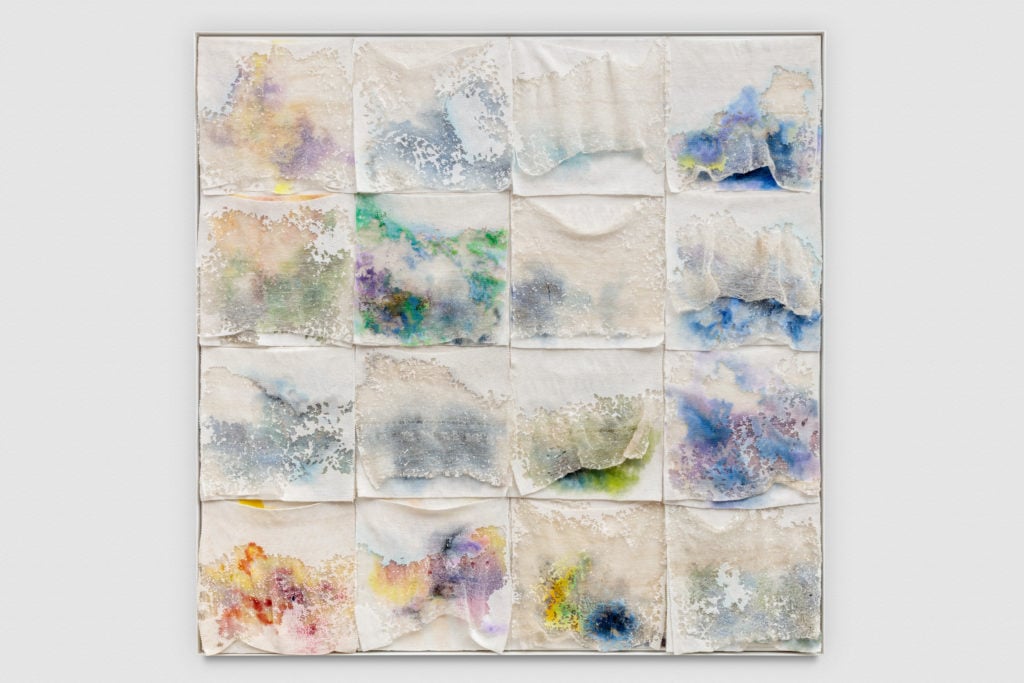
Liza Lou, Pyrocumulus (2018). Photo by Joshua White, courtesy of the artist and Lehmann Maupin, New York, Hong Kong, and Seoul.
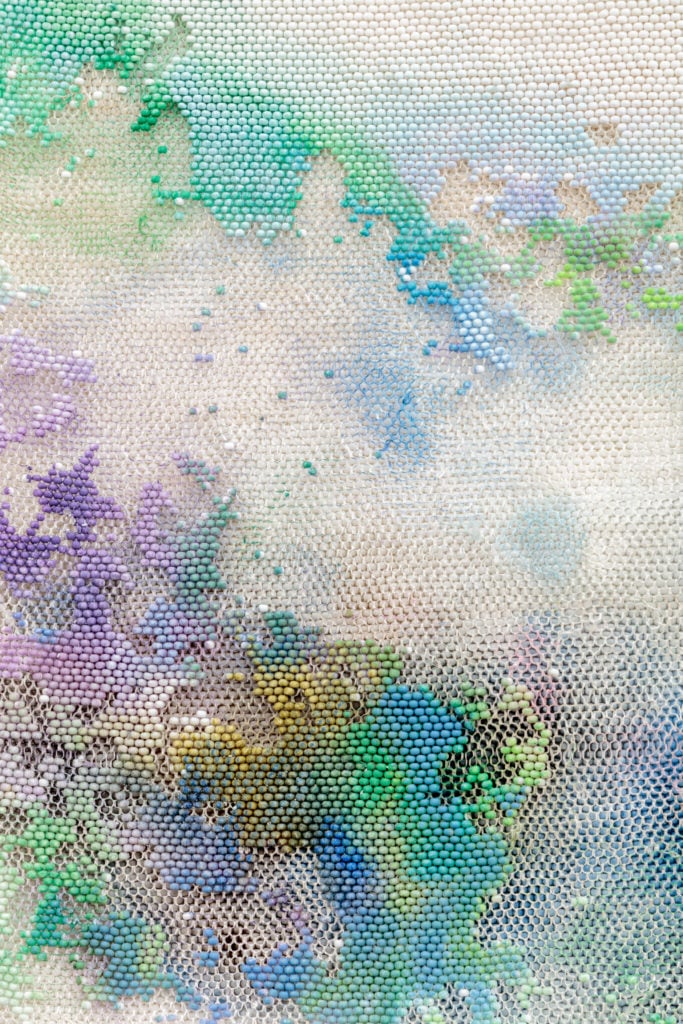
Liza Lou, Pyrocumulus (2018), detail. Photo by Joshua White, courtesy of the artist and Lehmann Maupin, New York, Hong Kong, and Seoul.

Liza Lou, Noctilucent (2018). Photo by Joshua White, courtesy of the artist and Lehmann Maupin, New York, Hong Kong, and Seoul.
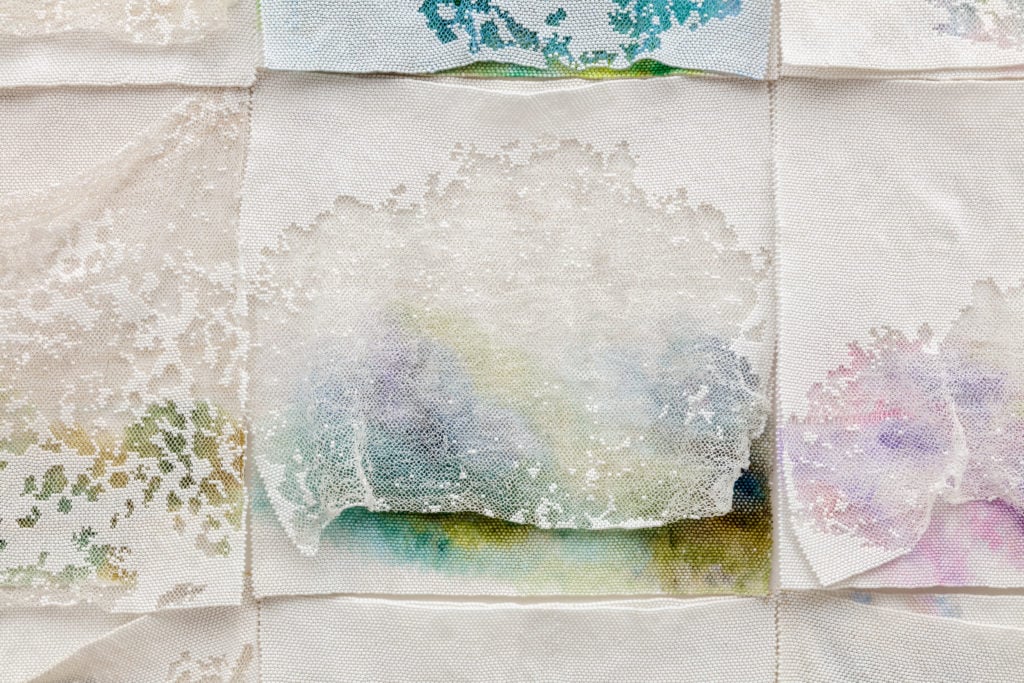
Liza Lou, Noctilucent (2018), detail. Photo by Joshua White, courtesy of the artist and Lehmann Maupin, New York, Hong Kong, and Seoul.
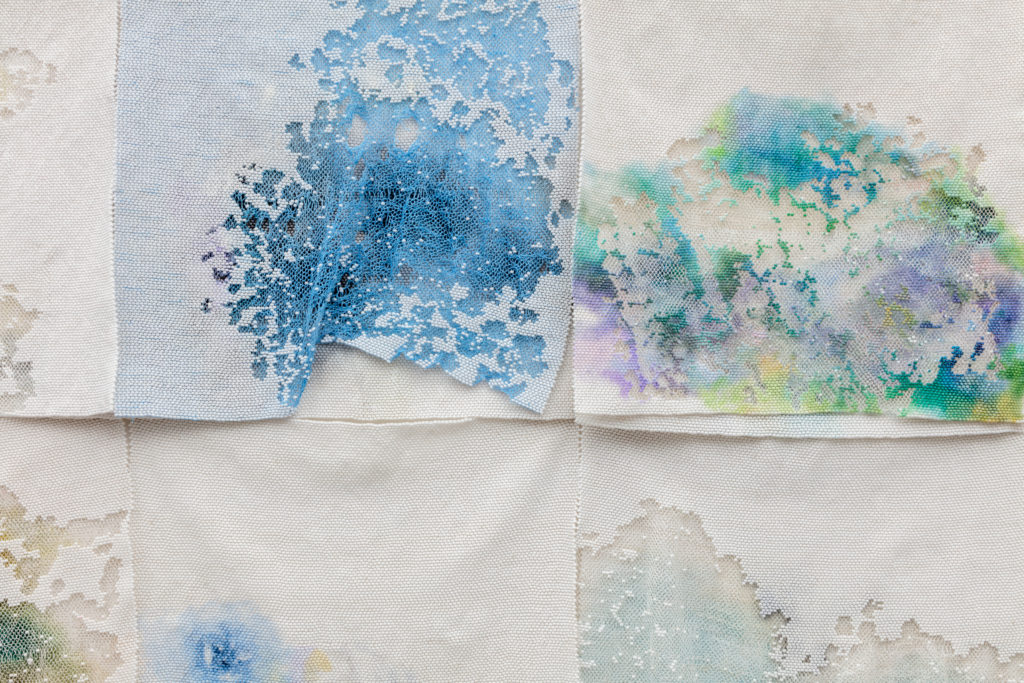
Liza Lou, Noctilucent (2018), detail. Photo by Joshua White, courtesy of the artist and Lehmann Maupin, New York, Hong Kong, and Seoul.
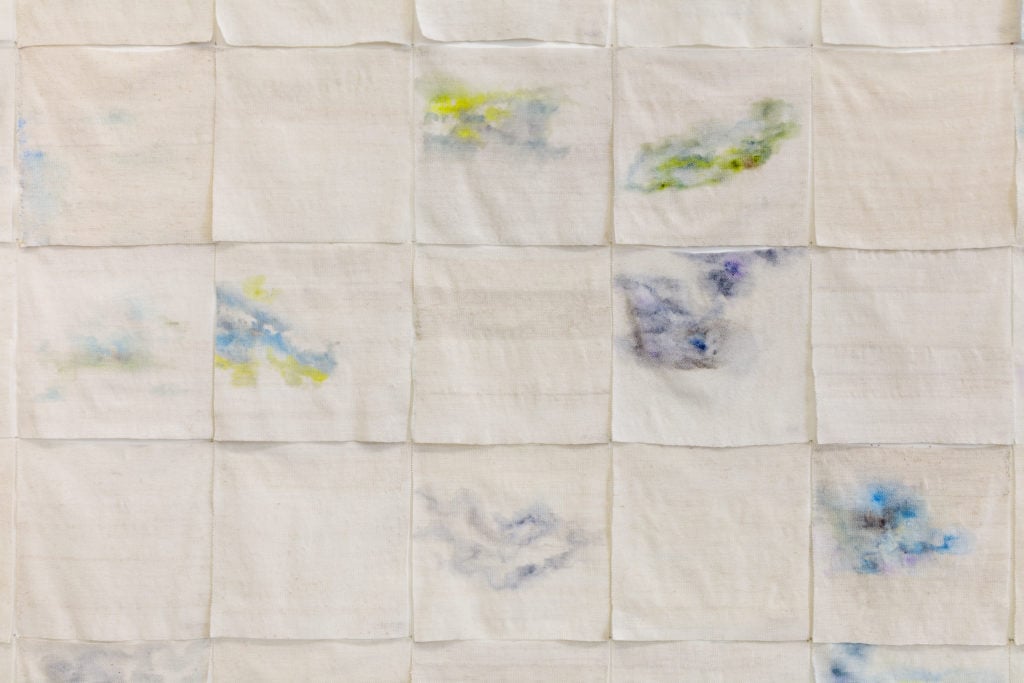
Liza Lou, The Clouds (2015–18), detail. Photo by Joshua White, courtesy of the artist and Lehmann Maupin, New York, Hong Kong, and Seoul.
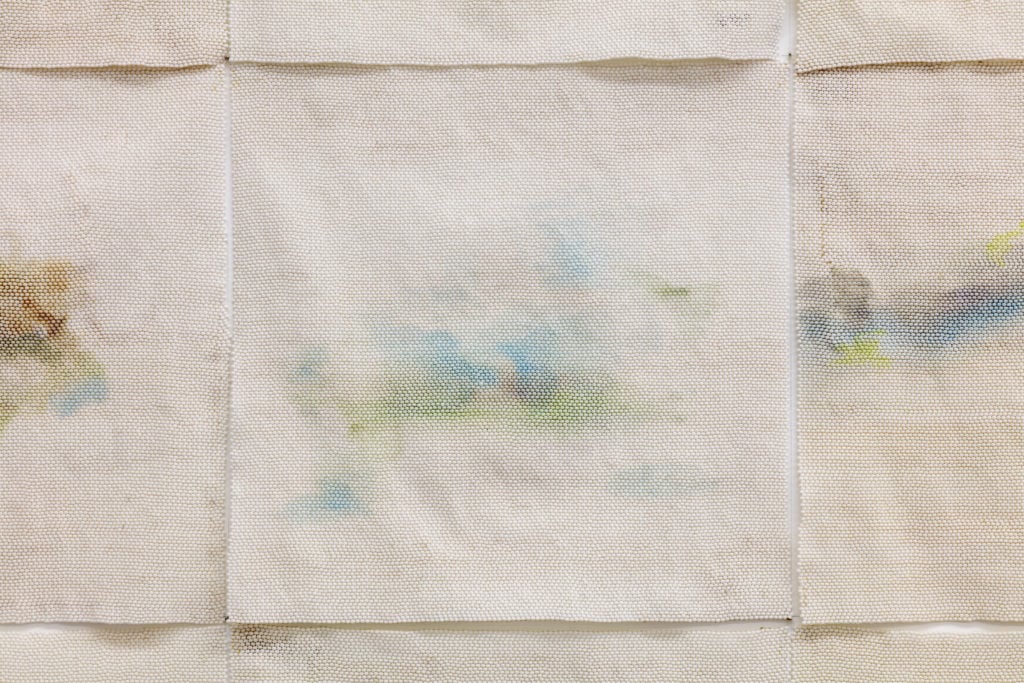
Liza Lou, The Clouds (2015–18), detail. Photo by Joshua White, courtesy of the artist and Lehmann Maupin, New York, Hong Kong, and Seoul.
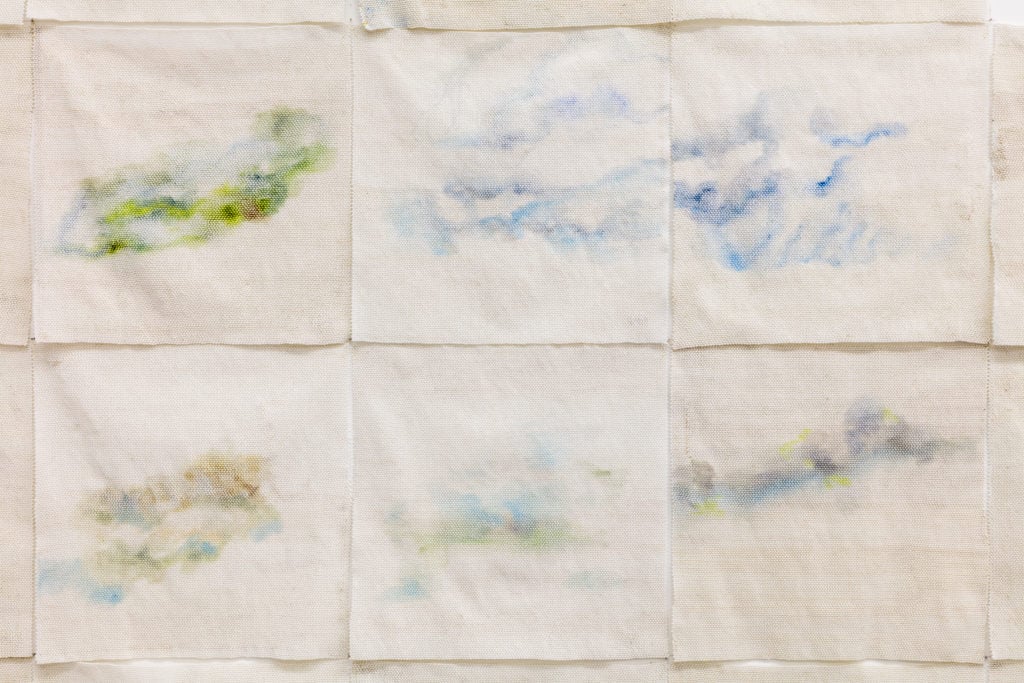
Liza Lou, The Clouds (2015–18), detail. Photo by Joshua White, courtesy of the artist and Lehmann Maupin, New York, Hong Kong, and Seoul.
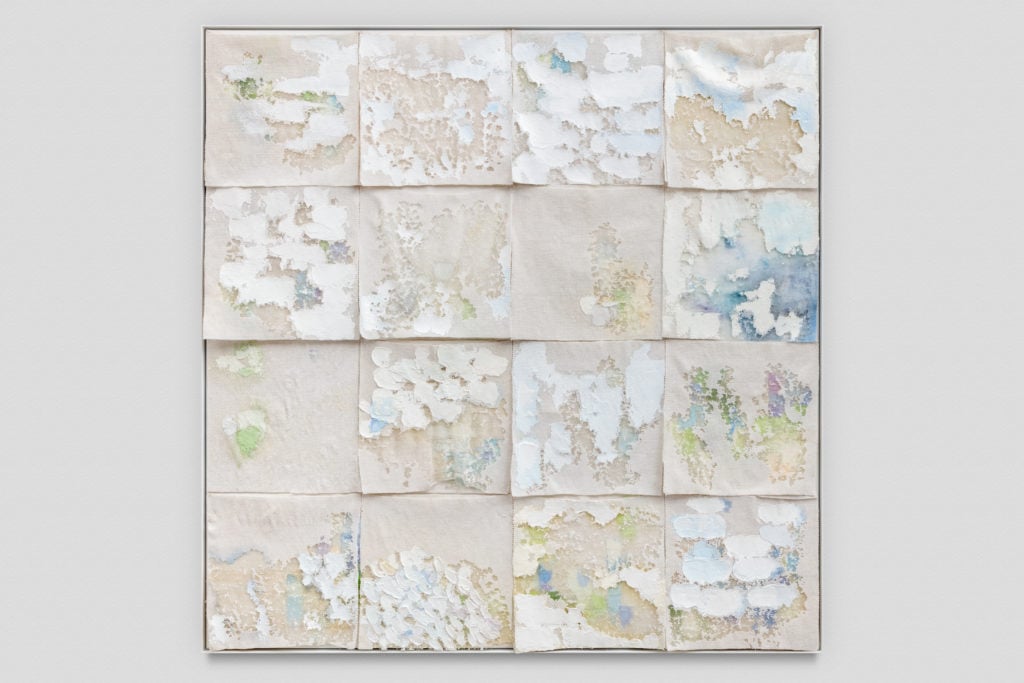
Liza Lou, Floccus (2018). Photo by Joshua White, courtesy of the artist and Lehmann Maupin, New York, Hong Kong, and Seoul.
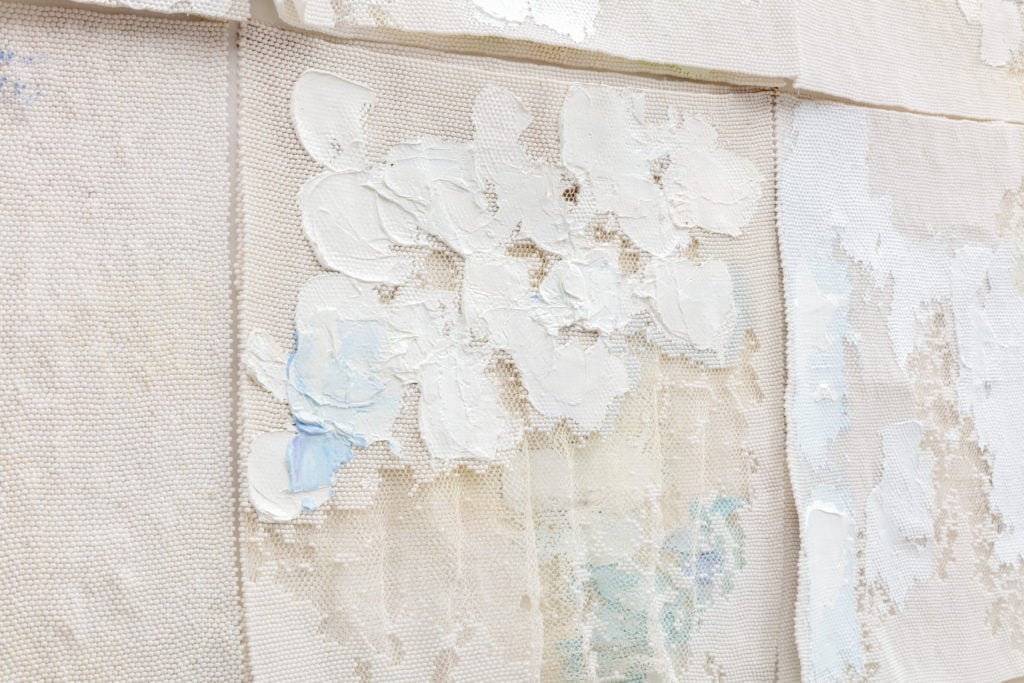
Liza Lou, Floccus (2018), detail. Photo by Joshua White, courtesy of the artist and Lehmann Maupin, New York, Hong Kong, and Seoul.
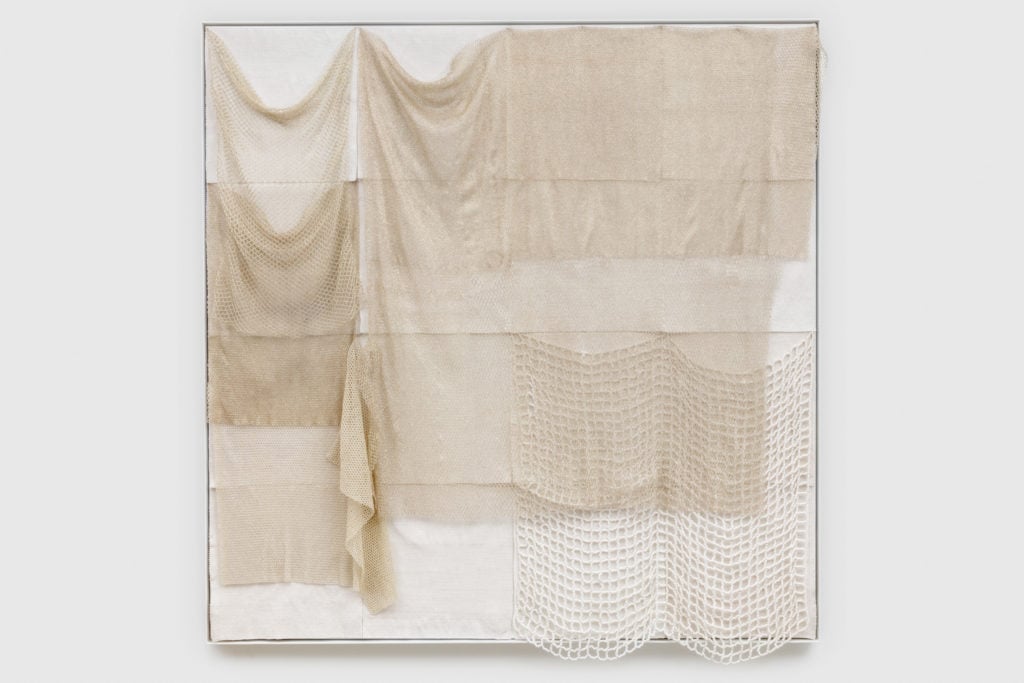
Liza Lou, Lacunosis (2018). Photo by Joshua White, courtesy of the artist and Lehmann Maupin, New York, Hong Kong, and Seoul.
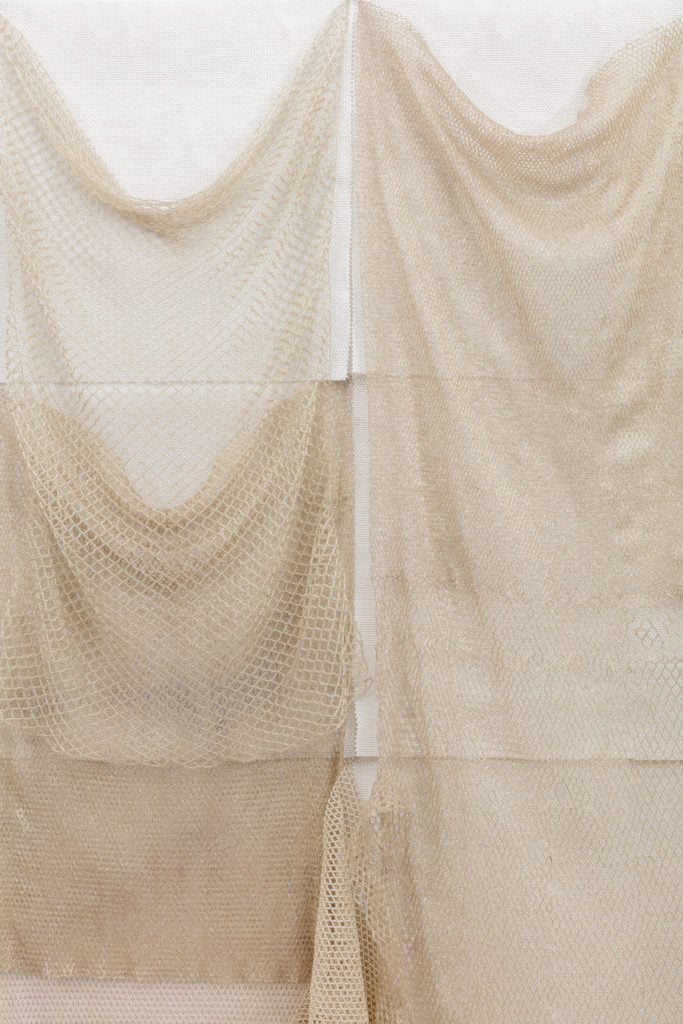
Liza Lou, Lacunosis (2018), detail. Photo by Joshua White, courtesy of the artist and Lehmann Maupin, New York, Hong Kong, and Seoul.
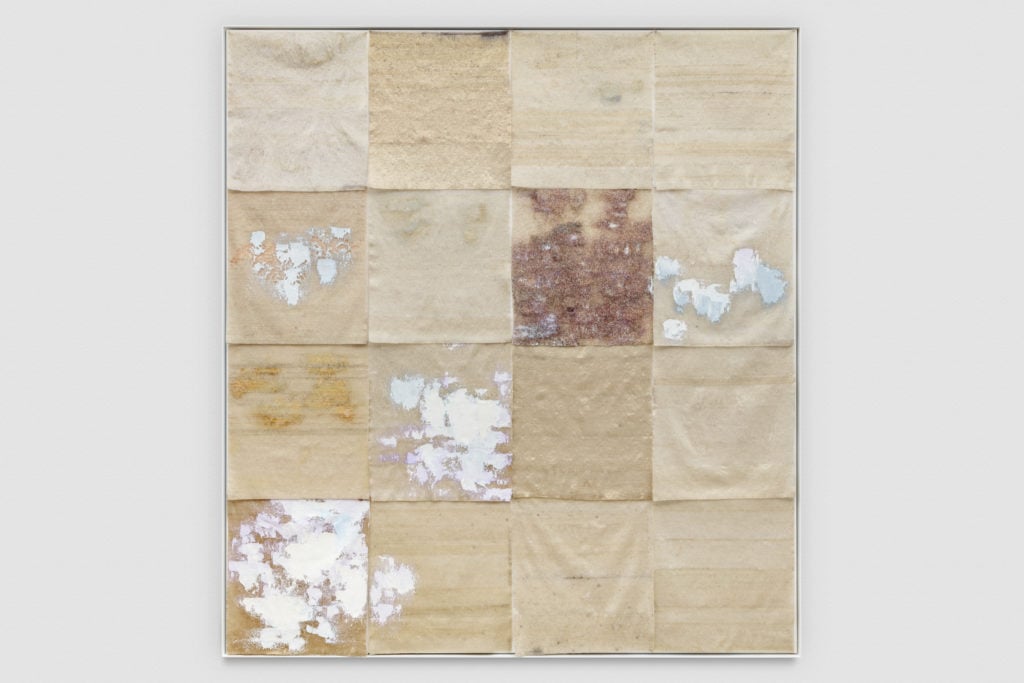
Liza Lou, Translucidus (2018). Photo by Joshua White, courtesy of the artist and Lehmann Maupin, New York, Hong Kong, and Seoul.
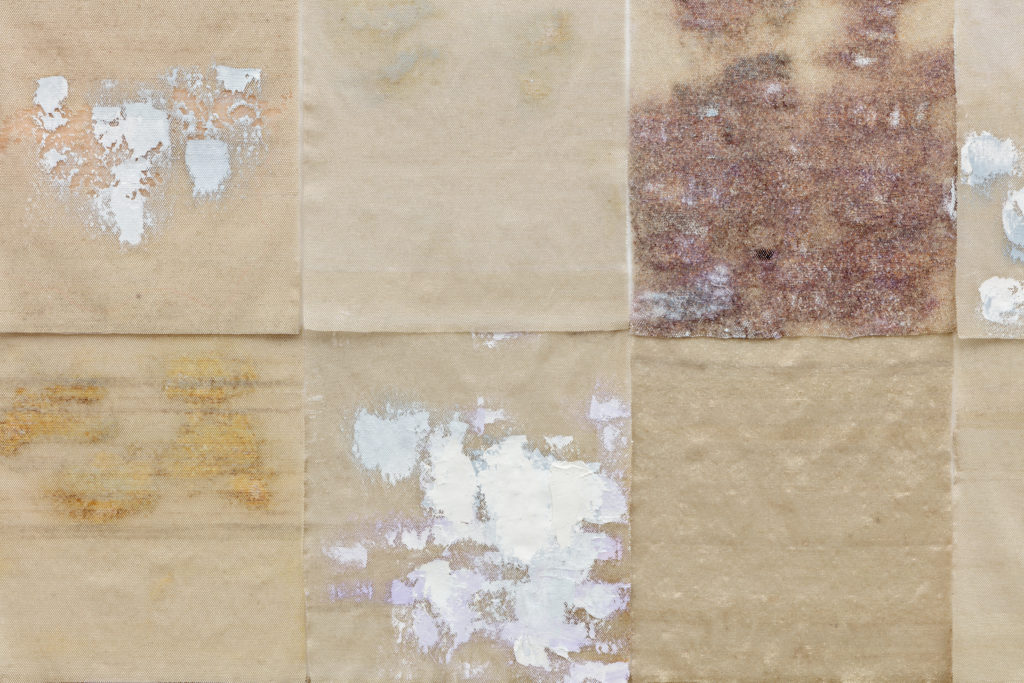
Liza Lou, Translucidus (2018), detail. Photo by Joshua White, courtesy of the artist and Lehmann Maupin, New York, Hong Kong, and Seoul.
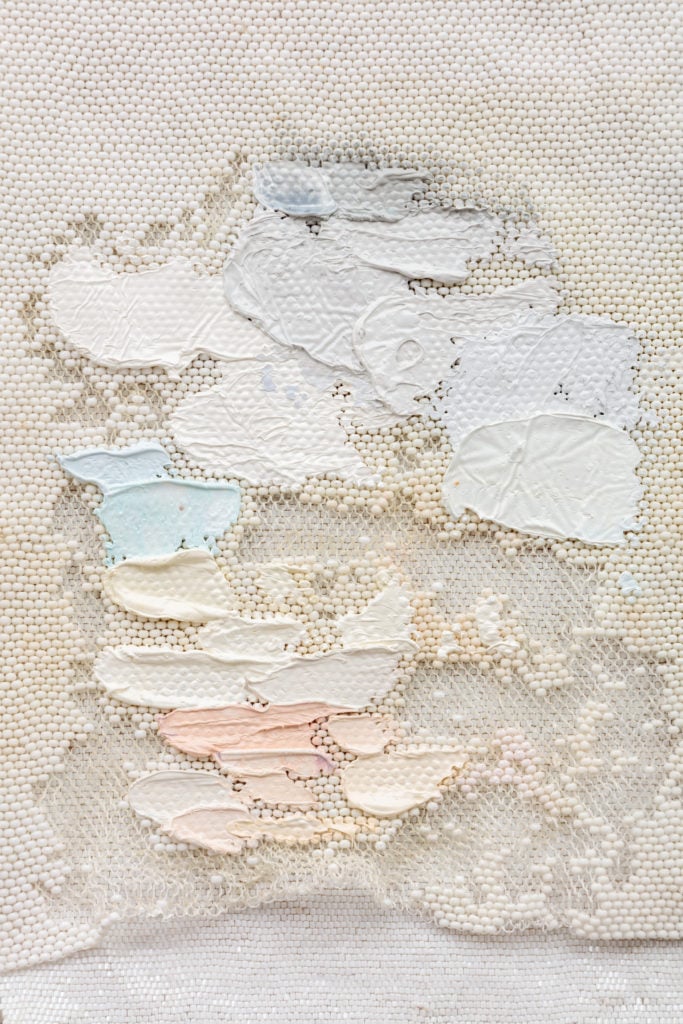
Liza Lou, Stratus Fractus (2018), detail. Photo by Joshua White, courtesy of the artist and Lehmann Maupin, New York, Hong Kong, and Seoul.
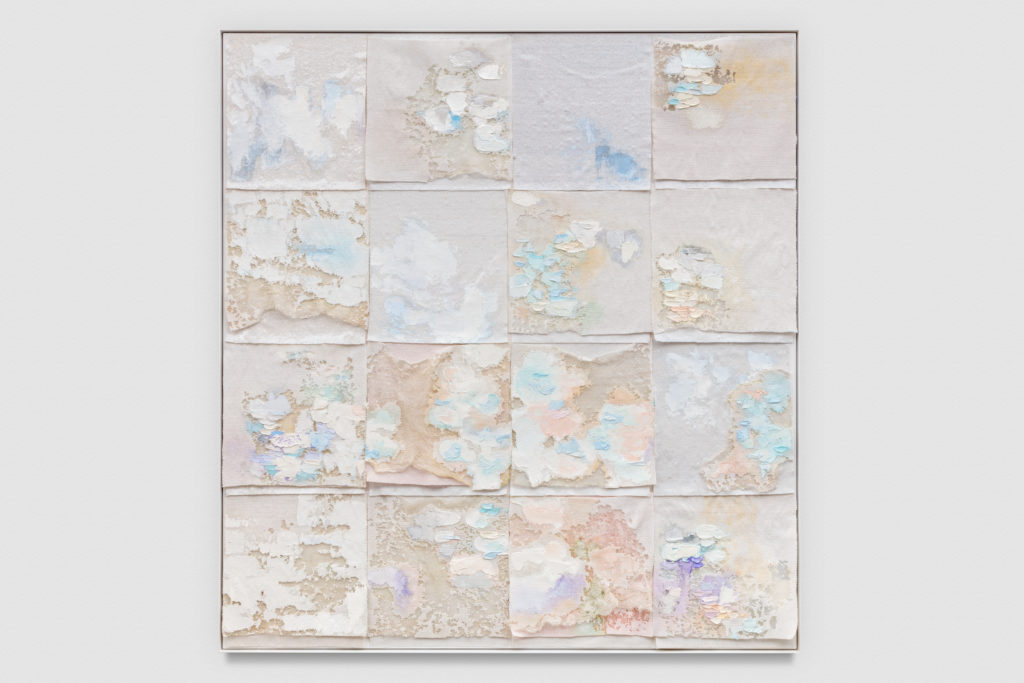
Liza Lou, Stratus Fractus (2018). Photo by Joshua White, courtesy of the artist and Lehmann Maupin, New York, Hong Kong, and Seoul.
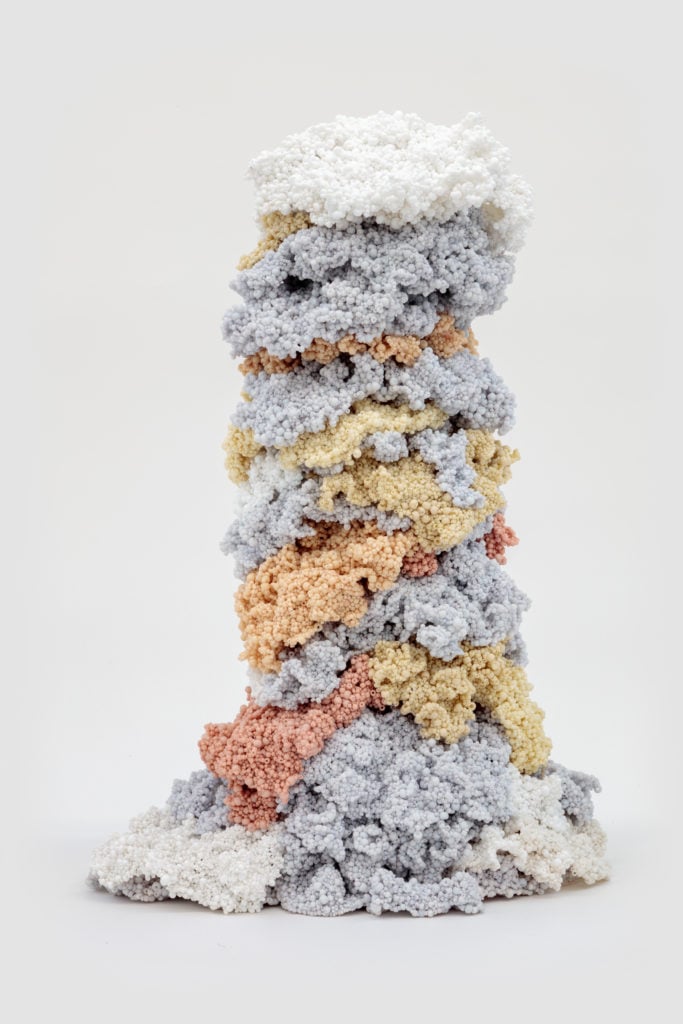
Liza Lou, Aggregate: Mushroom (2018). Photo by Joshua White, courtesy of the artist and Lehmann Maupin, New York, Hong Kong, and Seoul.
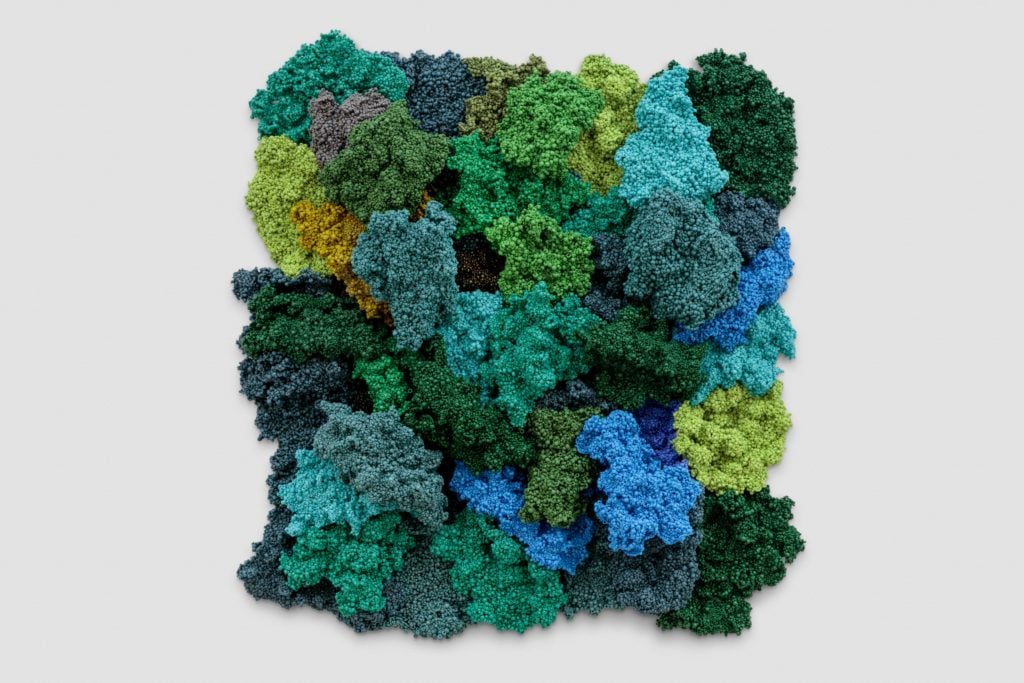
Liza Lou, Lichenform I (2018). Photo by Joshua White, courtesy of the artist and Lehmann Maupin, New York, Hong Kong, and Seoul.
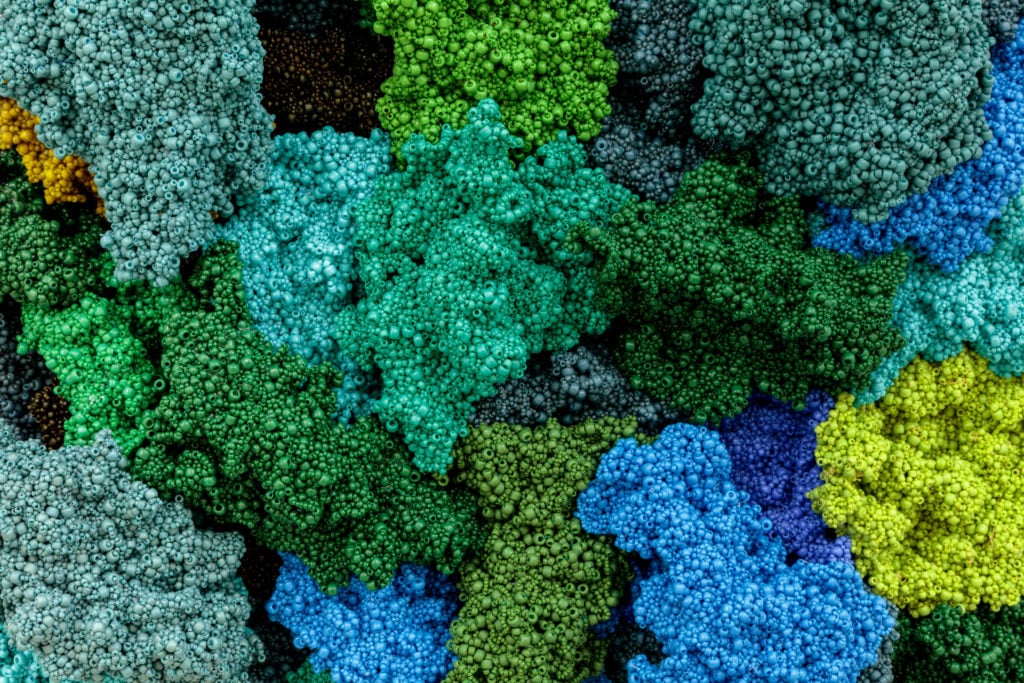
Liza Lou, Lichenform I (2018), detail. Photo by Joshua White, courtesy of the artist and Lehmann Maupin, New York, Hong Kong, and Seoul.
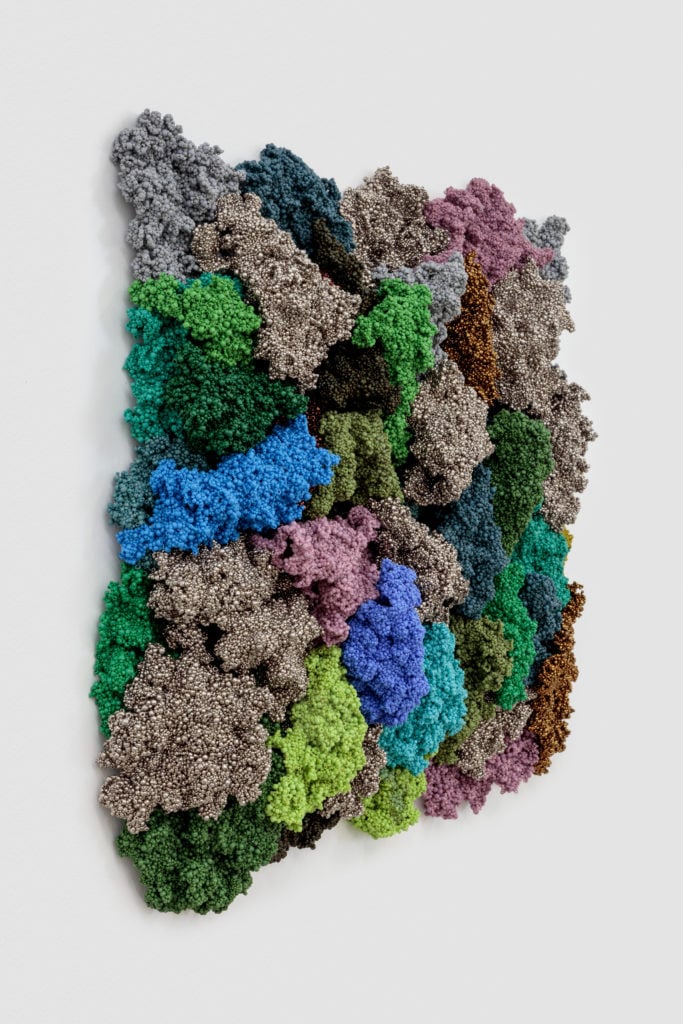
Liza Lou, Lichenform II (2018). Photo by Joshua White, courtesy of the artist and Lehmann Maupin, New York, Hong Kong, and Seoul.
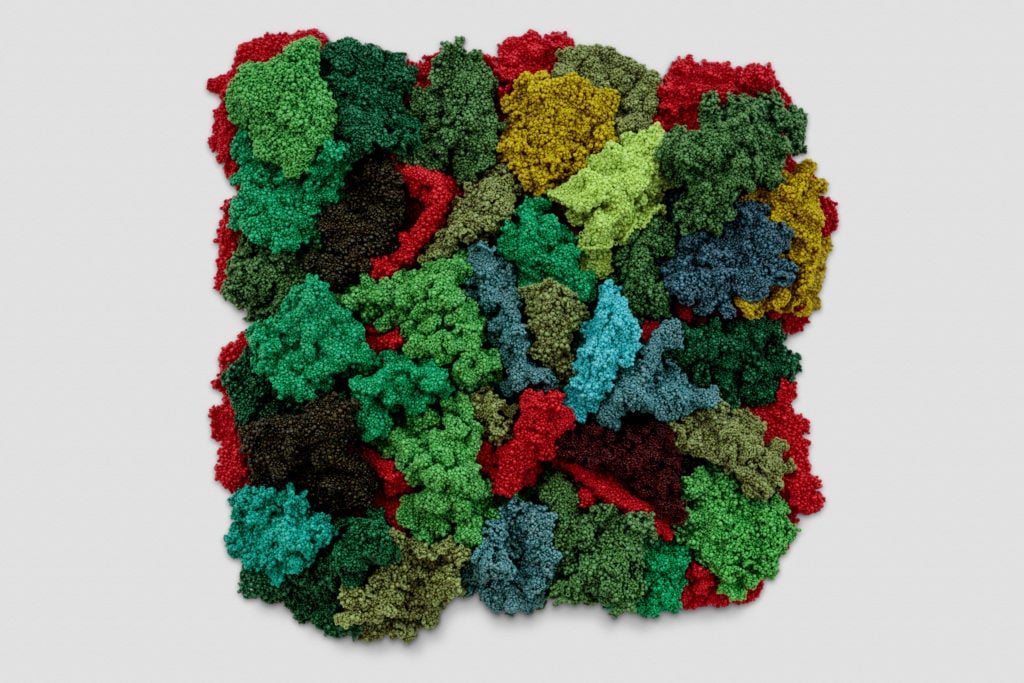
Liza Lou, Lichenform III (2018). Photo by Joshua White, courtesy of the artist and Lehmann Maupin, New York, Hong Kong, and Seoul.
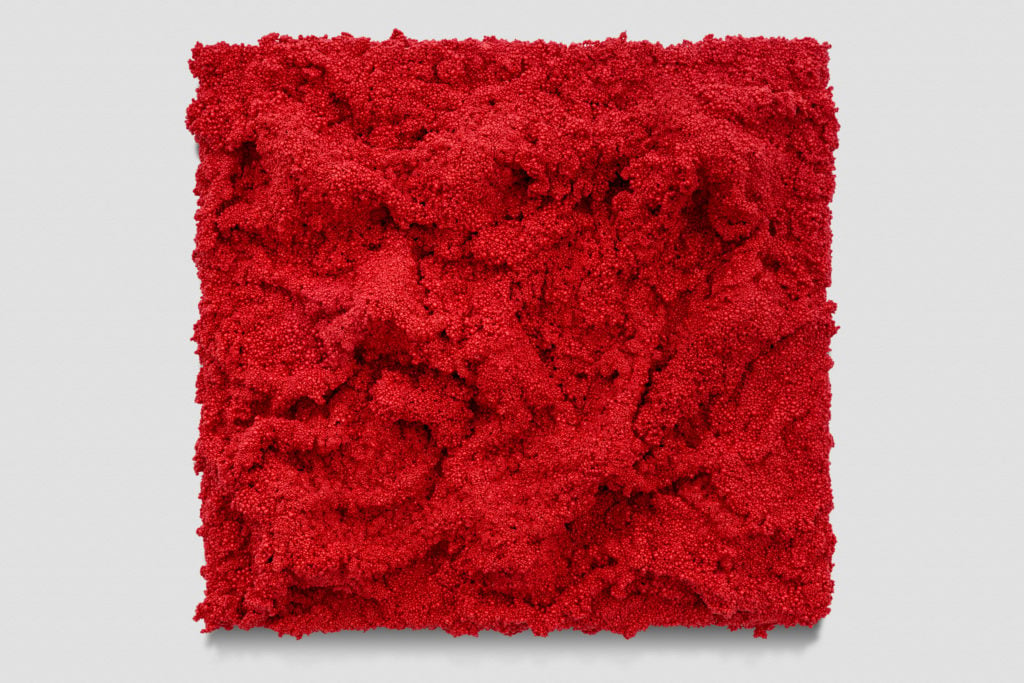
Liza Lou, Pyroclastic (2018). Photo by Joshua White, courtesy of the artist and Lehmann Maupin, New York, Hong Kong, and Seoul.
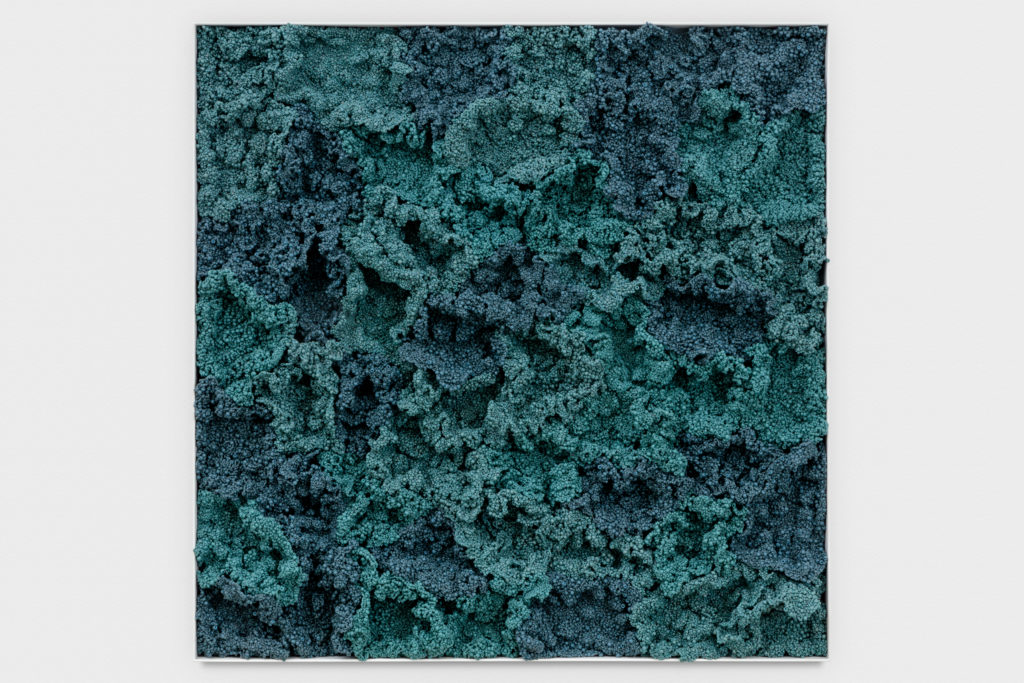
Liza Lou, Terra | Cloud (2018). Photo by Joshua White, courtesy of the artist and Lehmann Maupin, New York, Hong Kong, and Seoul.
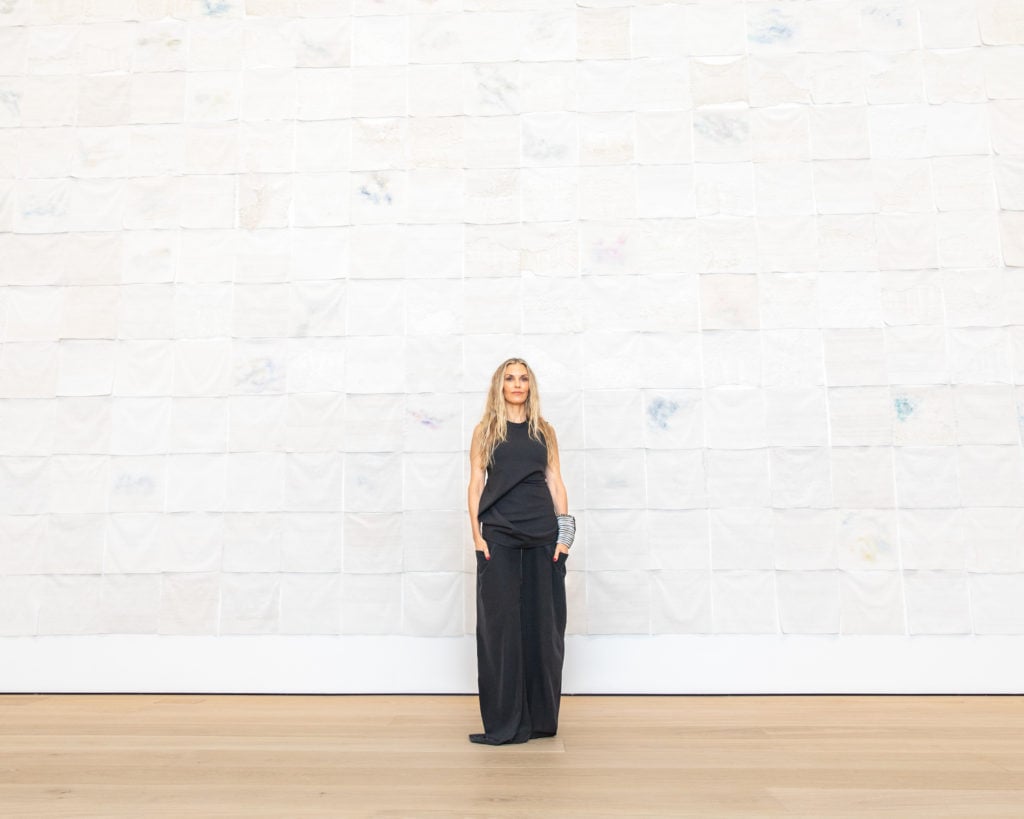
Liza Lou with her pieceThe Clouds at Lehmann Maupin. Photo by Benjamin Lozovsky/BFA.
“Liza Lou: Classification and Nomenclature of Clouds” is on view at Lehmann Maupin, 501 West 24th Street and 536 West 22nd Street, through October 27.